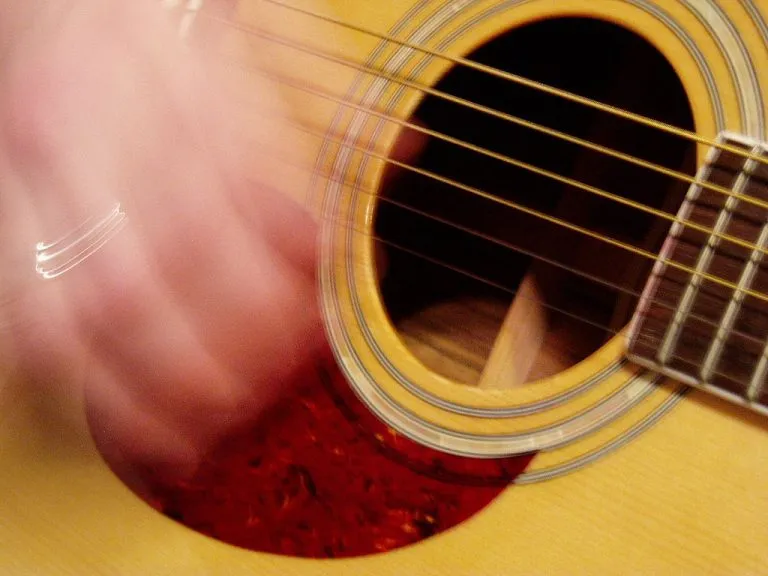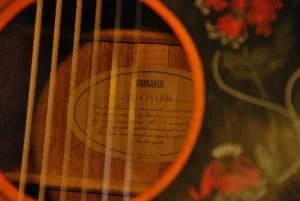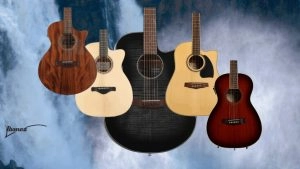Strumming is one of the most important things you will learn as a beginner guitarist. Yes, you need to learn chords, but what good are they if you can’t get them to ring out? For some, strumming comes easy; for others, it’s a struggle.
As a working musician, I can tell you that you’ll encounter many of the same patterns for songs. So, it’s a good idea to master a few different rhythmic strumming techniques in the early stages of learning guitar. If aren’t confident with a strumming technique, your guitar could sound bad.
Whether you play an electric guitar or an acoustic — with or without a pick — you’re going to face some challenges. Luckily, I’ll cover all of this and more, so you can learn how to strum a guitar with proficiency.
Strumming Guitar 101: Why Is It Important?
Before we dive into it, we need to discuss exactly why it’s important. Playing guitar is one part pressing down on the right frets and strings, and one part picking out or strumming those notes.
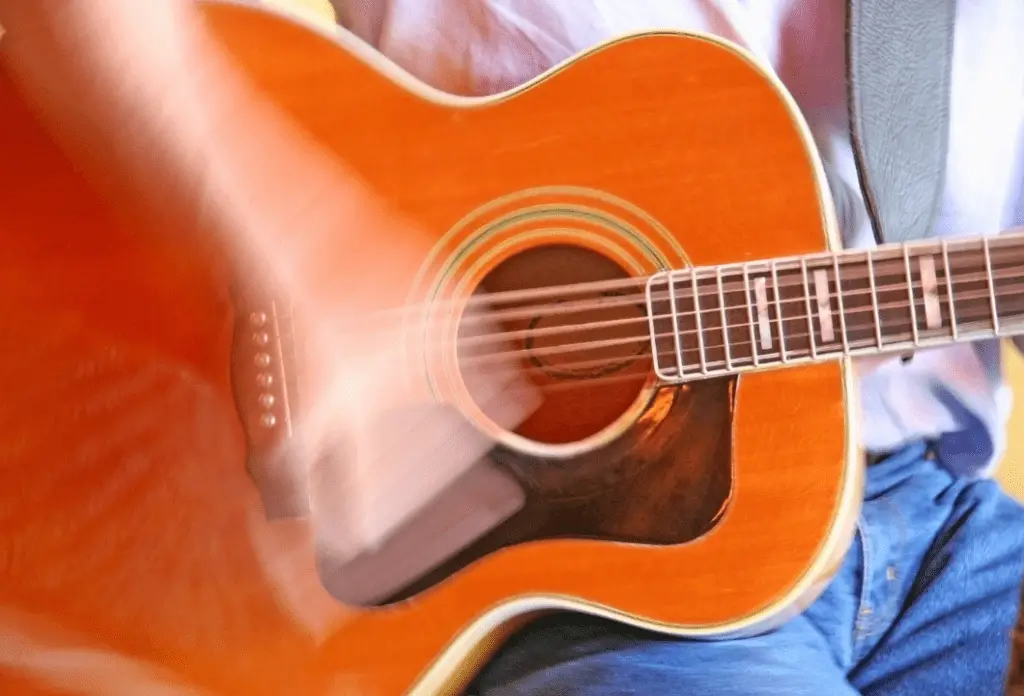
In other words, strumming is the rhythm aspect of playing songs on guitar.
While you can play chords with single down-strums and get close enough to the real deal — like today’s pop stars (1) — strumming is something you need to work on in order to become a great player. Many start with free YouTube guitar lessons to develop some general practice exercises.
Learning to strum correctly also helps you to work on your timing. Playing in time is incredibly important to improve your musicianship no matter what instrument you play.
• • •
Guitar Strumming: How to Do It Properly
Truth be told, there are actually several ways to strum a guitar properly but there are a few things to consider.
How to Hold a Guitar
First things first: You can’t properly strum a guitar if you’re not holding it right.

While sitting, it’s a safe bet to place the groove of the guitar over your leg. Your right leg if you’re right-handed or left leg if you’re left-handed. The neck of the guitar should come across the left of your body as a right-hander and vice-versa.
We recommend using a strap whether you’re sitting or standing. Consistency is key, and using a strap helps you keep the guitar in the same position every time. This is especially true for electric guitars, as the body is thinner, it’s more susceptible to sliding around while you play.
Posture is imperative too. When you’re a beginner, it’s very tempting to bend the top half of your body over the top of your guitar to look at the strings as you play guitar. While it’s unavoidable to eliminate, if you catch yourself doing this remember to sit up straight again.
How to Hold a Guitar Pick
Using a guitar pick is the most common way to strum a guitar. It’s easier on the fingers of beginners and allows for good projection on acoustic guitars. Still, many prefer to strum with their fingers, which we will also discuss.
To hold a pick:

- Place the pick on your index finger. The tip of the pick should face the same direction as your finger
- Lower your thumb onto the top of the pick so that it points out the side of your thumb
As a beginner learning to strum, we recommend using a light gauge pick. They are easier to drag across the strings when playing chords. If you don’t like how that feels on your index finger and thumb, get a thicker pick next time—they’re pretty cheap.
Strumming Technique With a Pick
Now that you’re holding the guitar and pick correctly, it’s time to strum!
The trick is to line up your strumming arm parallel to the face of the guitar. You should not have your wrist bent and aiming toward the strings. Instead, your wrist and hand should make a straight line from your elbow.
Some things to keep in mind:
- Use a thin pick
- Keep your wrist straight
- Strum from your elbow
- Don’t lock your wrist up (it can move up and down a little but not in and out)
Have the pick floating above the bottom E string and move up and down all the strings a few times. This won’t sound particularly good without a chord. But familiarizing yourself with the feeling of a pick moving across the strings is more important than the sound, for now.
If you’re using a thin pick, there shouldn’t be much resistance, so you can keep your wrist stiff and strum from your elbow. Picture your arm as though it has no joints from the elbow down.
On the other hand, if your pick is a little thicker, you have to give a little less resistance in the grip of your fingers, and perhaps in your wrist too. (Another reason why a thin pick is best for a beginner.) Still, you will have to master angling a pick eventually.
Finger Strumming: How to Strum Without a Pick
While it’s not the ideal way of learning guitar in terms of quick progress, many guitarists do prefer to strum without a pick. It may also help you learn fingerstyle playing quicker.
There are actually quite a few different ways to strum without a pick. You can check out some examples in this video:
Although there’s no rule saying you have to use your strumming hand in a certain way, the better way to strum without a pick is to use your index finger. It will create a brighter sound than using your thumb. It will also:
- Be more consistent sounding
- Help you play with a pick later
- Help you master fingerpicking later
Strumming without a pick in that fashion also allows you to strum from your elbow, which is the more ‘correct’ way to strum. When using your thumb, you’re much more likely to strum with your wrist or the thumb itself.
Just like with a pick, try working on your strumming first and avoid trying to incorporate chord changes when you start. Your fretting hand isn’t important for now. You’ll need to focus on getting more control of your strums first.
Is Thumb Picking Strumming?
It can be. Are you strumming over all the strings you need to play a chord or picking them out individually?
As long as you have control over the sound and you aren’t causing any pain to your wrists or thumb you can use your thumb. But, there will be inconsistency between your up and down strokes as the fleshy part of your thumb will hit the strings on the way down and your nail on the way up.
Using your thumb is majorly important for complex fingerpicking patterns so incorporating it as part of your playstyle may actually help in the long run. Just don’t become too reliant on it. Practice other strumming styles, too.
Strumming an Acoustic Guitar vs. Electric Guitar
There’s not a huge difference between strumming on an electric guitar and electric guitar. But, there are some factors to consider.
One example is that it’s tougher on your fingers to strum acoustic guitars without a pick. The strings are a little tougher, especially for newbies.

A second factor is the type of songs you’ll play. Many electric guitar-based songs focus on a lot of down strums while acoustic songs usually have fairly consistent down and up patterns.
The position of your strumming arm can also be different. The larger body on an acoustic often helps newer players get their arm in the correct position. Using an electric guitar means you have to be more mindful.
The feel is also different. Neither is really harder than the other to play, but you might have a little trouble when moving from an acoustic to an electric or the other way around.
• • •
Guitar Strumming Pattern Exercises to Practice
Learning a few strumming patterns will allow you to play a huge range of songs. Even if they’re not exactly right, they still sound good enough to sing along to if that’s your goal.
Note: If you’re unfamiliar with these terms, I highly recommend signing up for online guitar lessons.
1. Down Down Down Down

Boring right? But, you need to learn to walk before you can run.
Most songs are in the time signature of 4/4. That just means there are four beats per bar. You don’t need to know exactly what this means for now. But, practicing four down strums will come in very handy for helping with your timing.
You can strum the guitar four times, change chords, strum another four, etc. This will also help you with your chord transitions.
2. Down Up Down Up

Another simple one. Once you’ve mastered the single strums with downstrokes, try adding upward strums too. Just to familiarize yourself with them.
You can play the same chords and with the same timing you’ve already been practicing with.
3. Down Down Up Down Down Up

This is a nice easy one to conquer to start to get a little rhythm into your playing. This pattern also allows you to master playing certain strings with the down and up strums.
You could also try picking the bass note out first with this pattern.
Check out the video here for a deeper explanation and some more strumming patterns to try.
• • •
Strumming FAQs
What hand do you strum a guitar with?

You strum with your dominant hand. So, right-handed players will strum with their right hand. Left-handed players will strum with their left hands.
Your fretting hand should be your non-dominant hand.
Why is strumming technique so important?
You simply can’t sound good with bad strumming—no matter how confident you are with the chords.
Bad strumming technique can also lead to injury. Relying on your wrist too much can cause damage to your nerves. Leaning over the guitar too much can also cause back issues.
What finger do you use to strum a guitar?

With a guitar pick, you should use your first finger and thumb.
Without a guitar pick, using your first finger is best. You can also use your thumb.
How do you strum smoothly?
Make sure you strum from your elbow with your wrist in line with your elbow. Try not to have excessive movement past the strings. You only need to move your strumming hand the width of the six strings.
Can you play electric without a guitar pick?
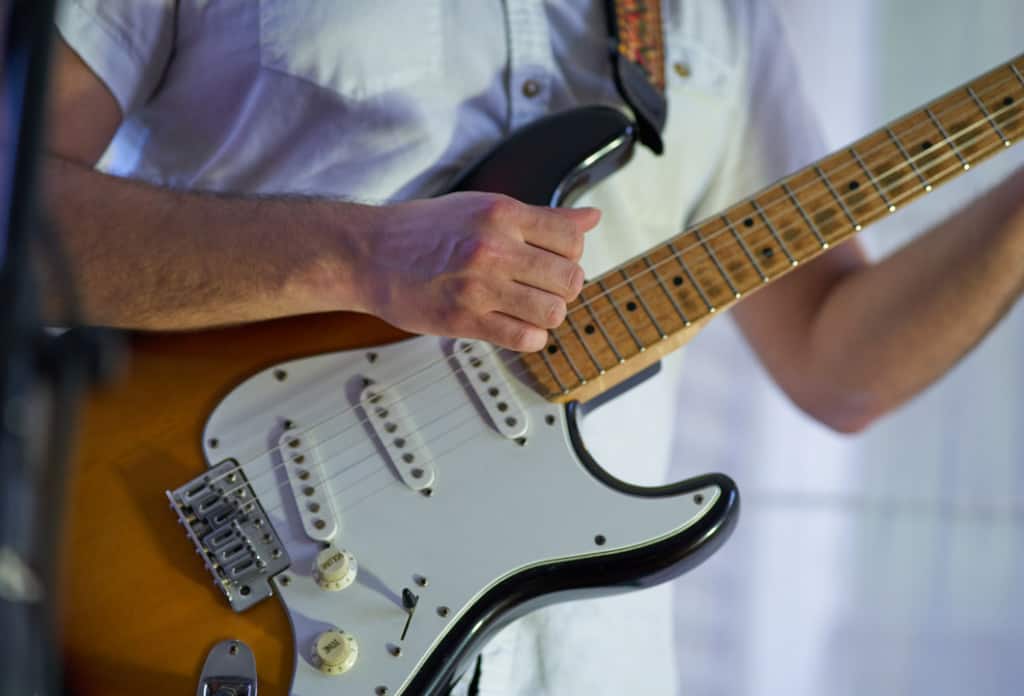
Yes, you can! It’s less common than acoustic guitar but many artists play electric guitars without a guitar pick like Jeff Beck. It’s really up to you where you take your guitar journey and there’s no hard and fast rules of what you’re allowed to play.
• • •
Start Strumming Today

Inspired to go all Cory Wong (the king of syncopated strumming!) on your next practice session (2)? I hope you’ve learned a thing or two and have a better appreciation for the art of strumming a guitar.
• • •
References
- Graham Hartmann, “Can Pop Stars Actually Play Guitar?” As published here: https://loudwire.com/can-pop-stars-actually-play-guitar/
- Adrian Clark, “Cory Wong shows you how to sharpen up your rhythmic precision in this exclusive lesson,” as published here: https://www.guitarworld.com/lessons/cory-wong-shows-you-how-to-sharpen-up-your-rhythmic-precision-in-this-exclusive-lesson
• • •
Image credits
Featured image: Sam DeLong from Cedarville, OH, United StatesSam DeLong from Cedarville, OH, United States, CC BY-SA 2.0, via Wikimedia Commons.

